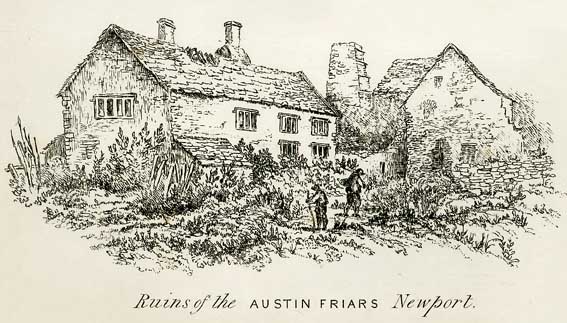 |
||
|
RUINS
OF THE AUSTIN FRIARS NEWPORT The Monastery of Austin Friars In the fourth volume
of Leland's Itinerary,
page 53, we read, "Newport is a bigge Towne, whereof that parte
where the Paroche Chirch is stondith on a Hille," etc. and a marginal
note informs us that "there was a house of Reliqion by the Key
beneth the Bridge," and this short and unsatisfactory notice is
all that the learned antiquary, writing about the year 1540, thought
proper to record of the little monastery in question. Dugdale, our great
authority on monastic history, knew nothing about it. In Tanner's Notitia
(I quote Nasmith's edition) the author contents himself with quoting
Leland's note, adding a conjecture of his own, that "it was probably
(a house) of Friars Preachers, because such a one was granted in 35th
Henry 8th to Sir Edward Carne." In a note to this he observes,
"though I met with one John Cregory, frater Augustin de Newport,"
(MS., in Bibl: Coll: Univ: Oxon:) This shows that he had some misgivings
that his conjecture was not based upon a very sure foundation; Cox,
however, adopted it, and we learn from him, writing in 1800, that the
remains of the monastery then consisted of "several detached buildings
containing comfortable apartments, and a spacious hall, with gothic
windows neatly finished in freestone;" the body of the church was
dilapidated; but the northern transept was a "small but elegant
specimen of gothic architecture." It is to be regretted that he
gives no view or plan of these remains, which have now entirely disappeared,
so that the etching, by our friend and associate Mr. Lee, from a sketch
taken by him previous to its destruction, which illustrates this paper,
is the only memorial we possess of this ancient edifice. Of the order
to which it belonged, the era of its foundation, and name of the founder,
of which hitherto no account has appeared, I am fortunately enabled
to supply the particulars. It belonged to the Austin Friars, or as they
styled themselves, "Hermits of Saint Augustine." They claimed
as their founder the saint himself, not the apostle of the Anglo Saxons,
but the eminent African Bishop, and Father of the church, who is said
to have instituted the order about the year 388, in the neighbourhood
of his native town of Tegasté in Numidia. The order became extinct
on the invasion of Africa by the Vandals, but was revived in Europe
in the 18th century, and introduced into England about 1250. Their dress
in the house was white, but in the choir, or when they went abroad,
they wore over all a long black gown with wide sleeves and a hood, and
a girdle of black leather fastened with a pin of bone or ivory. The
Staffords were great patrons of this order; Ralph, Earl of Stafford,
the first Lord of Newport and Wentllwch of the family, founded a house
for them at Stafford in 1344, and some of the family, another at Shrewsbury.
From a document in the possession of Sir Thomas Phillipps, Bart: of
Middle Hill, a transcript of which is in the collection of our President,
it appears that this house at Newport was founded in the year 1377 by
Hugh, son of Ralph, who succeeded his father as second Earl of Stafford,
and Lord of Newport and Wentllwch, in 1372. It may be that it was considered
as a cell to the house at Stafford; at all events the probability is,
that the first of the order who were established at Newport, came from
that place. |
||